EEP417 Assignment: Ethical Dilemma in Early Childhood Education
VerifiedAdded on 2023/04/25
|8
|2186
|223
Essay
AI Summary
This essay presents a case study of an ethical dilemma encountered in an early childhood education setting. The core issue revolves around a two-and-a-half-year-old girl named Mayah who requires sleep after lunch, a practice that conflicts with her parents' concerns about her nighttime sleep schedule. The educator believes allowing Mayah to sleep is in her best interest, while the parents believe it interferes with their ability to put her to sleep at night. The essay explores the ethical dimensions of this conflict, examining the educator's duty, the parents' concerns, and the principles of the UNCRC, NQS, EYLF, and the ECA Code of Ethics. It discusses the resolution reached through collaboration between the educator, parents, and the institution, including regulated sleep hours and communication strategies. The essay highlights the importance of transparency and communication in resolving such dilemmas and emphasizes the educator's role in holistic child development.
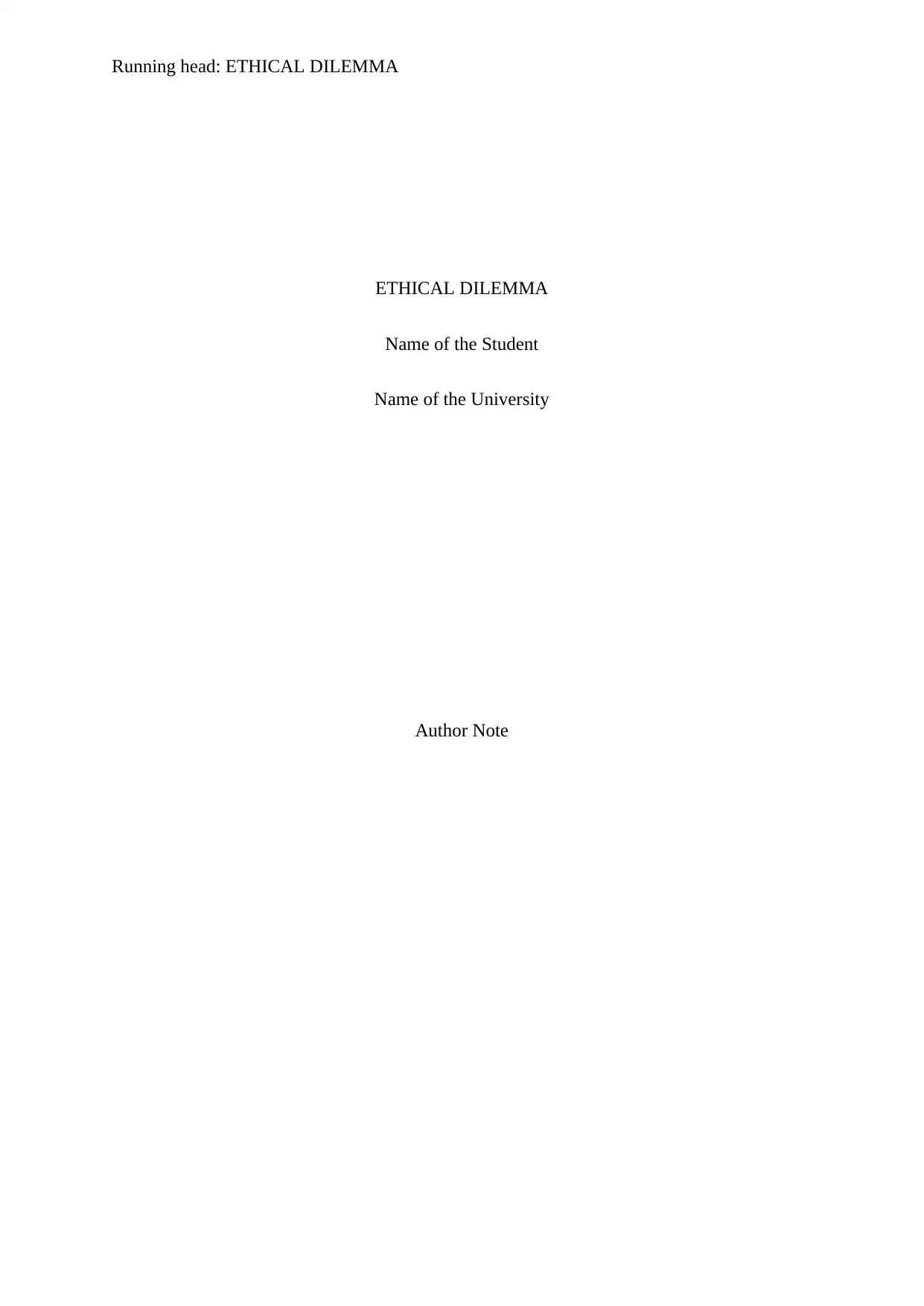
Running head: ETHICAL DILEMMA
ETHICAL DILEMMA
Name of the Student
Name of the University
Author Note
ETHICAL DILEMMA
Name of the Student
Name of the University
Author Note
Paraphrase This Document
Need a fresh take? Get an instant paraphrase of this document with our AI Paraphraser
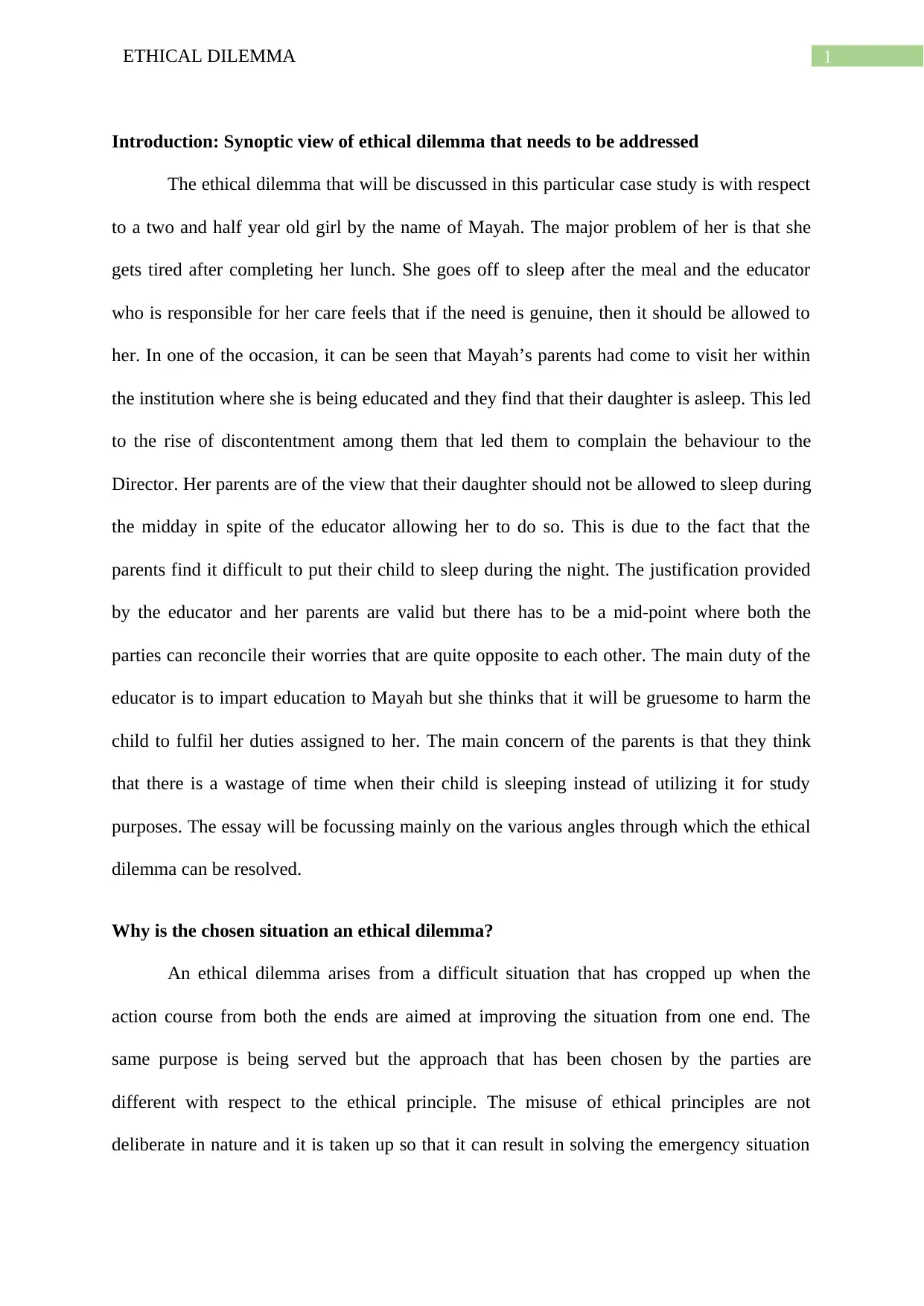
1ETHICAL DILEMMA
Introduction: Synoptic view of ethical dilemma that needs to be addressed
The ethical dilemma that will be discussed in this particular case study is with respect
to a two and half year old girl by the name of Mayah. The major problem of her is that she
gets tired after completing her lunch. She goes off to sleep after the meal and the educator
who is responsible for her care feels that if the need is genuine, then it should be allowed to
her. In one of the occasion, it can be seen that Mayah’s parents had come to visit her within
the institution where she is being educated and they find that their daughter is asleep. This led
to the rise of discontentment among them that led them to complain the behaviour to the
Director. Her parents are of the view that their daughter should not be allowed to sleep during
the midday in spite of the educator allowing her to do so. This is due to the fact that the
parents find it difficult to put their child to sleep during the night. The justification provided
by the educator and her parents are valid but there has to be a mid-point where both the
parties can reconcile their worries that are quite opposite to each other. The main duty of the
educator is to impart education to Mayah but she thinks that it will be gruesome to harm the
child to fulfil her duties assigned to her. The main concern of the parents is that they think
that there is a wastage of time when their child is sleeping instead of utilizing it for study
purposes. The essay will be focussing mainly on the various angles through which the ethical
dilemma can be resolved.
Why is the chosen situation an ethical dilemma?
An ethical dilemma arises from a difficult situation that has cropped up when the
action course from both the ends are aimed at improving the situation from one end. The
same purpose is being served but the approach that has been chosen by the parties are
different with respect to the ethical principle. The misuse of ethical principles are not
deliberate in nature and it is taken up so that it can result in solving the emergency situation
Introduction: Synoptic view of ethical dilemma that needs to be addressed
The ethical dilemma that will be discussed in this particular case study is with respect
to a two and half year old girl by the name of Mayah. The major problem of her is that she
gets tired after completing her lunch. She goes off to sleep after the meal and the educator
who is responsible for her care feels that if the need is genuine, then it should be allowed to
her. In one of the occasion, it can be seen that Mayah’s parents had come to visit her within
the institution where she is being educated and they find that their daughter is asleep. This led
to the rise of discontentment among them that led them to complain the behaviour to the
Director. Her parents are of the view that their daughter should not be allowed to sleep during
the midday in spite of the educator allowing her to do so. This is due to the fact that the
parents find it difficult to put their child to sleep during the night. The justification provided
by the educator and her parents are valid but there has to be a mid-point where both the
parties can reconcile their worries that are quite opposite to each other. The main duty of the
educator is to impart education to Mayah but she thinks that it will be gruesome to harm the
child to fulfil her duties assigned to her. The main concern of the parents is that they think
that there is a wastage of time when their child is sleeping instead of utilizing it for study
purposes. The essay will be focussing mainly on the various angles through which the ethical
dilemma can be resolved.
Why is the chosen situation an ethical dilemma?
An ethical dilemma arises from a difficult situation that has cropped up when the
action course from both the ends are aimed at improving the situation from one end. The
same purpose is being served but the approach that has been chosen by the parties are
different with respect to the ethical principle. The misuse of ethical principles are not
deliberate in nature and it is taken up so that it can result in solving the emergency situation
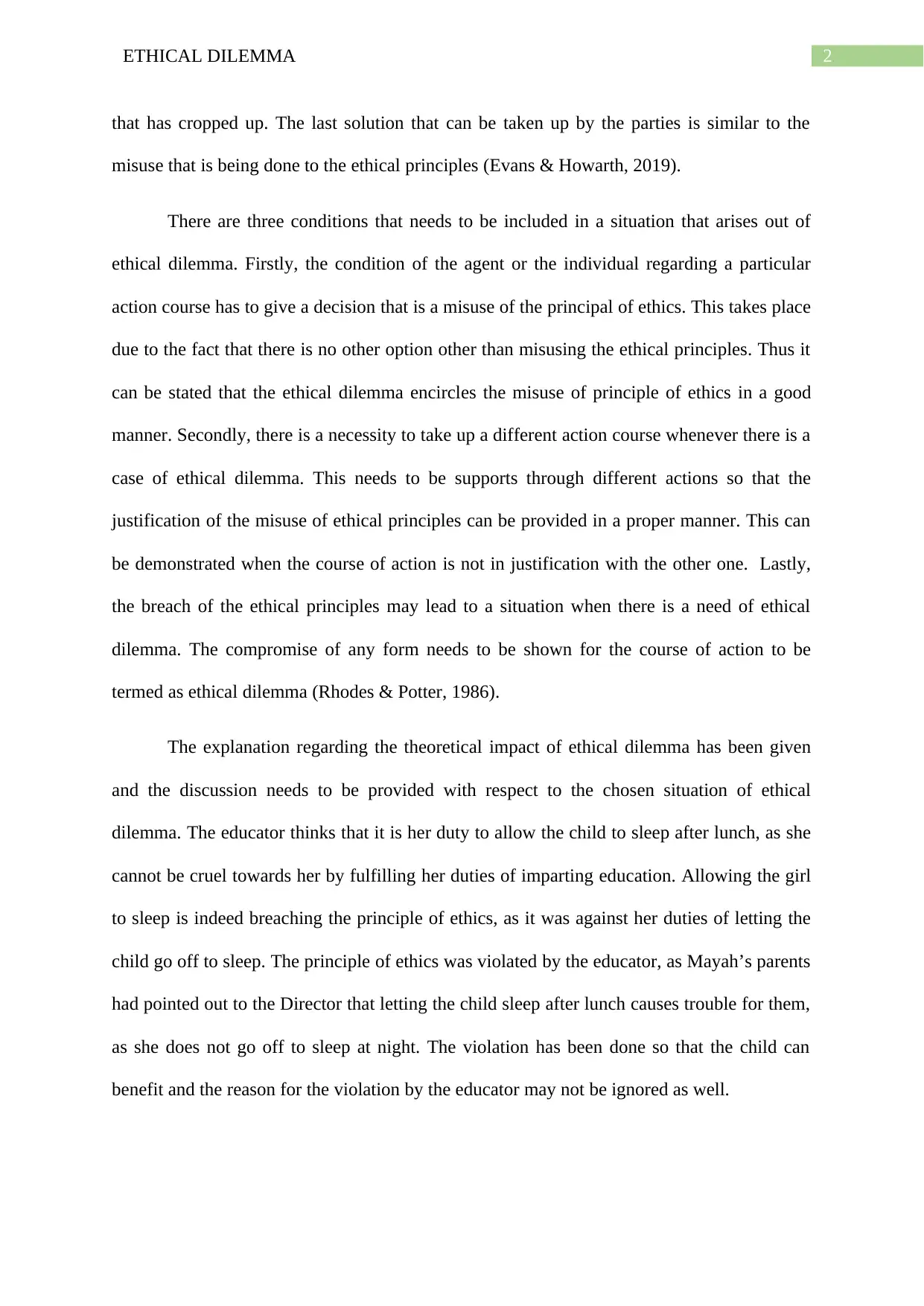
2ETHICAL DILEMMA
that has cropped up. The last solution that can be taken up by the parties is similar to the
misuse that is being done to the ethical principles (Evans & Howarth, 2019).
There are three conditions that needs to be included in a situation that arises out of
ethical dilemma. Firstly, the condition of the agent or the individual regarding a particular
action course has to give a decision that is a misuse of the principal of ethics. This takes place
due to the fact that there is no other option other than misusing the ethical principles. Thus it
can be stated that the ethical dilemma encircles the misuse of principle of ethics in a good
manner. Secondly, there is a necessity to take up a different action course whenever there is a
case of ethical dilemma. This needs to be supports through different actions so that the
justification of the misuse of ethical principles can be provided in a proper manner. This can
be demonstrated when the course of action is not in justification with the other one. Lastly,
the breach of the ethical principles may lead to a situation when there is a need of ethical
dilemma. The compromise of any form needs to be shown for the course of action to be
termed as ethical dilemma (Rhodes & Potter, 1986).
The explanation regarding the theoretical impact of ethical dilemma has been given
and the discussion needs to be provided with respect to the chosen situation of ethical
dilemma. The educator thinks that it is her duty to allow the child to sleep after lunch, as she
cannot be cruel towards her by fulfilling her duties of imparting education. Allowing the girl
to sleep is indeed breaching the principle of ethics, as it was against her duties of letting the
child go off to sleep. The principle of ethics was violated by the educator, as Mayah’s parents
had pointed out to the Director that letting the child sleep after lunch causes trouble for them,
as she does not go off to sleep at night. The violation has been done so that the child can
benefit and the reason for the violation by the educator may not be ignored as well.
that has cropped up. The last solution that can be taken up by the parties is similar to the
misuse that is being done to the ethical principles (Evans & Howarth, 2019).
There are three conditions that needs to be included in a situation that arises out of
ethical dilemma. Firstly, the condition of the agent or the individual regarding a particular
action course has to give a decision that is a misuse of the principal of ethics. This takes place
due to the fact that there is no other option other than misusing the ethical principles. Thus it
can be stated that the ethical dilemma encircles the misuse of principle of ethics in a good
manner. Secondly, there is a necessity to take up a different action course whenever there is a
case of ethical dilemma. This needs to be supports through different actions so that the
justification of the misuse of ethical principles can be provided in a proper manner. This can
be demonstrated when the course of action is not in justification with the other one. Lastly,
the breach of the ethical principles may lead to a situation when there is a need of ethical
dilemma. The compromise of any form needs to be shown for the course of action to be
termed as ethical dilemma (Rhodes & Potter, 1986).
The explanation regarding the theoretical impact of ethical dilemma has been given
and the discussion needs to be provided with respect to the chosen situation of ethical
dilemma. The educator thinks that it is her duty to allow the child to sleep after lunch, as she
cannot be cruel towards her by fulfilling her duties of imparting education. Allowing the girl
to sleep is indeed breaching the principle of ethics, as it was against her duties of letting the
child go off to sleep. The principle of ethics was violated by the educator, as Mayah’s parents
had pointed out to the Director that letting the child sleep after lunch causes trouble for them,
as she does not go off to sleep at night. The violation has been done so that the child can
benefit and the reason for the violation by the educator may not be ignored as well.
⊘ This is a preview!⊘
Do you want full access?
Subscribe today to unlock all pages.

Trusted by 1+ million students worldwide
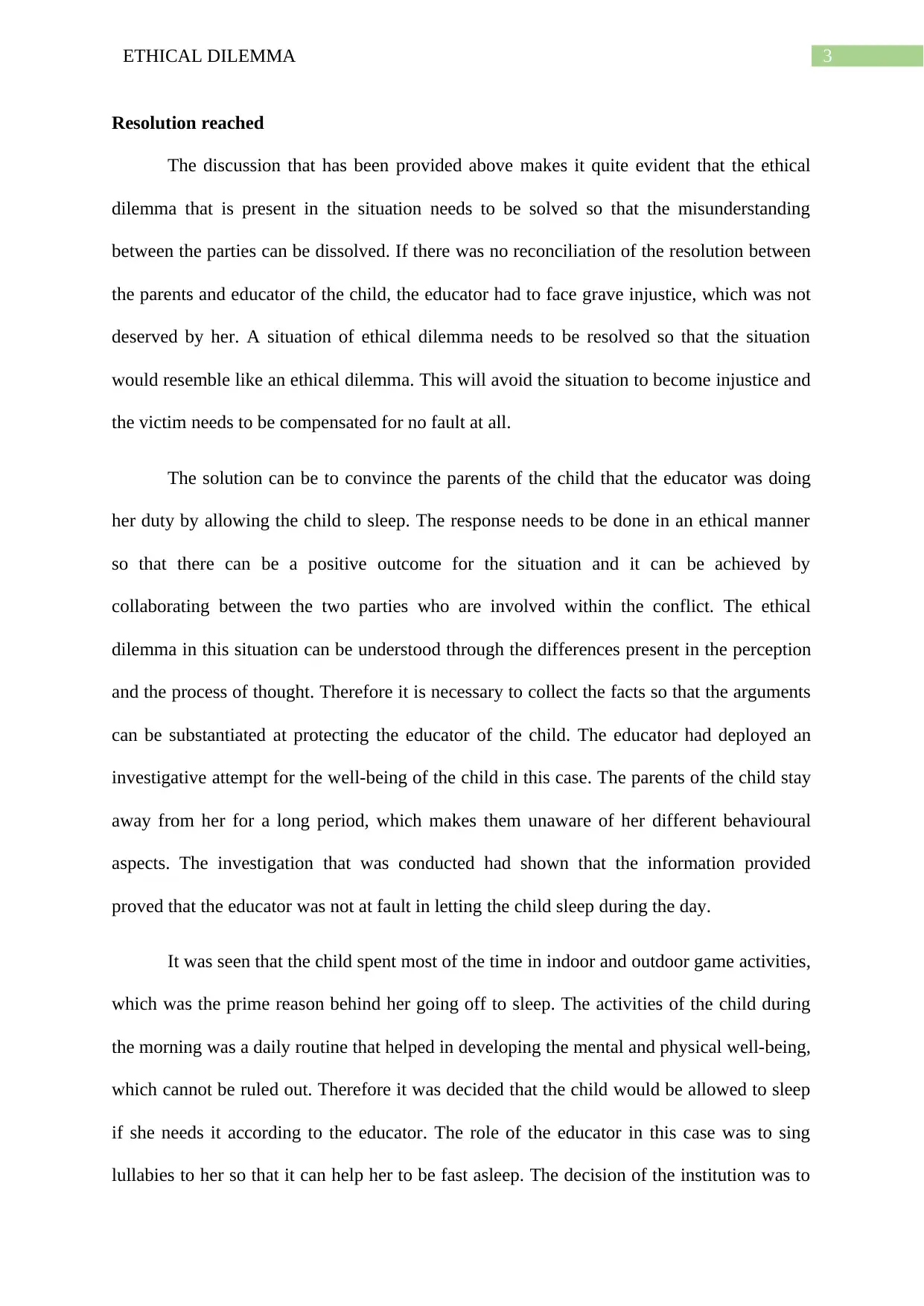
3ETHICAL DILEMMA
Resolution reached
The discussion that has been provided above makes it quite evident that the ethical
dilemma that is present in the situation needs to be solved so that the misunderstanding
between the parties can be dissolved. If there was no reconciliation of the resolution between
the parents and educator of the child, the educator had to face grave injustice, which was not
deserved by her. A situation of ethical dilemma needs to be resolved so that the situation
would resemble like an ethical dilemma. This will avoid the situation to become injustice and
the victim needs to be compensated for no fault at all.
The solution can be to convince the parents of the child that the educator was doing
her duty by allowing the child to sleep. The response needs to be done in an ethical manner
so that there can be a positive outcome for the situation and it can be achieved by
collaborating between the two parties who are involved within the conflict. The ethical
dilemma in this situation can be understood through the differences present in the perception
and the process of thought. Therefore it is necessary to collect the facts so that the arguments
can be substantiated at protecting the educator of the child. The educator had deployed an
investigative attempt for the well-being of the child in this case. The parents of the child stay
away from her for a long period, which makes them unaware of her different behavioural
aspects. The investigation that was conducted had shown that the information provided
proved that the educator was not at fault in letting the child sleep during the day.
It was seen that the child spent most of the time in indoor and outdoor game activities,
which was the prime reason behind her going off to sleep. The activities of the child during
the morning was a daily routine that helped in developing the mental and physical well-being,
which cannot be ruled out. Therefore it was decided that the child would be allowed to sleep
if she needs it according to the educator. The role of the educator in this case was to sing
lullabies to her so that it can help her to be fast asleep. The decision of the institution was to
Resolution reached
The discussion that has been provided above makes it quite evident that the ethical
dilemma that is present in the situation needs to be solved so that the misunderstanding
between the parties can be dissolved. If there was no reconciliation of the resolution between
the parents and educator of the child, the educator had to face grave injustice, which was not
deserved by her. A situation of ethical dilemma needs to be resolved so that the situation
would resemble like an ethical dilemma. This will avoid the situation to become injustice and
the victim needs to be compensated for no fault at all.
The solution can be to convince the parents of the child that the educator was doing
her duty by allowing the child to sleep. The response needs to be done in an ethical manner
so that there can be a positive outcome for the situation and it can be achieved by
collaborating between the two parties who are involved within the conflict. The ethical
dilemma in this situation can be understood through the differences present in the perception
and the process of thought. Therefore it is necessary to collect the facts so that the arguments
can be substantiated at protecting the educator of the child. The educator had deployed an
investigative attempt for the well-being of the child in this case. The parents of the child stay
away from her for a long period, which makes them unaware of her different behavioural
aspects. The investigation that was conducted had shown that the information provided
proved that the educator was not at fault in letting the child sleep during the day.
It was seen that the child spent most of the time in indoor and outdoor game activities,
which was the prime reason behind her going off to sleep. The activities of the child during
the morning was a daily routine that helped in developing the mental and physical well-being,
which cannot be ruled out. Therefore it was decided that the child would be allowed to sleep
if she needs it according to the educator. The role of the educator in this case was to sing
lullabies to her so that it can help her to be fast asleep. The decision of the institution was to
Paraphrase This Document
Need a fresh take? Get an instant paraphrase of this document with our AI Paraphraser
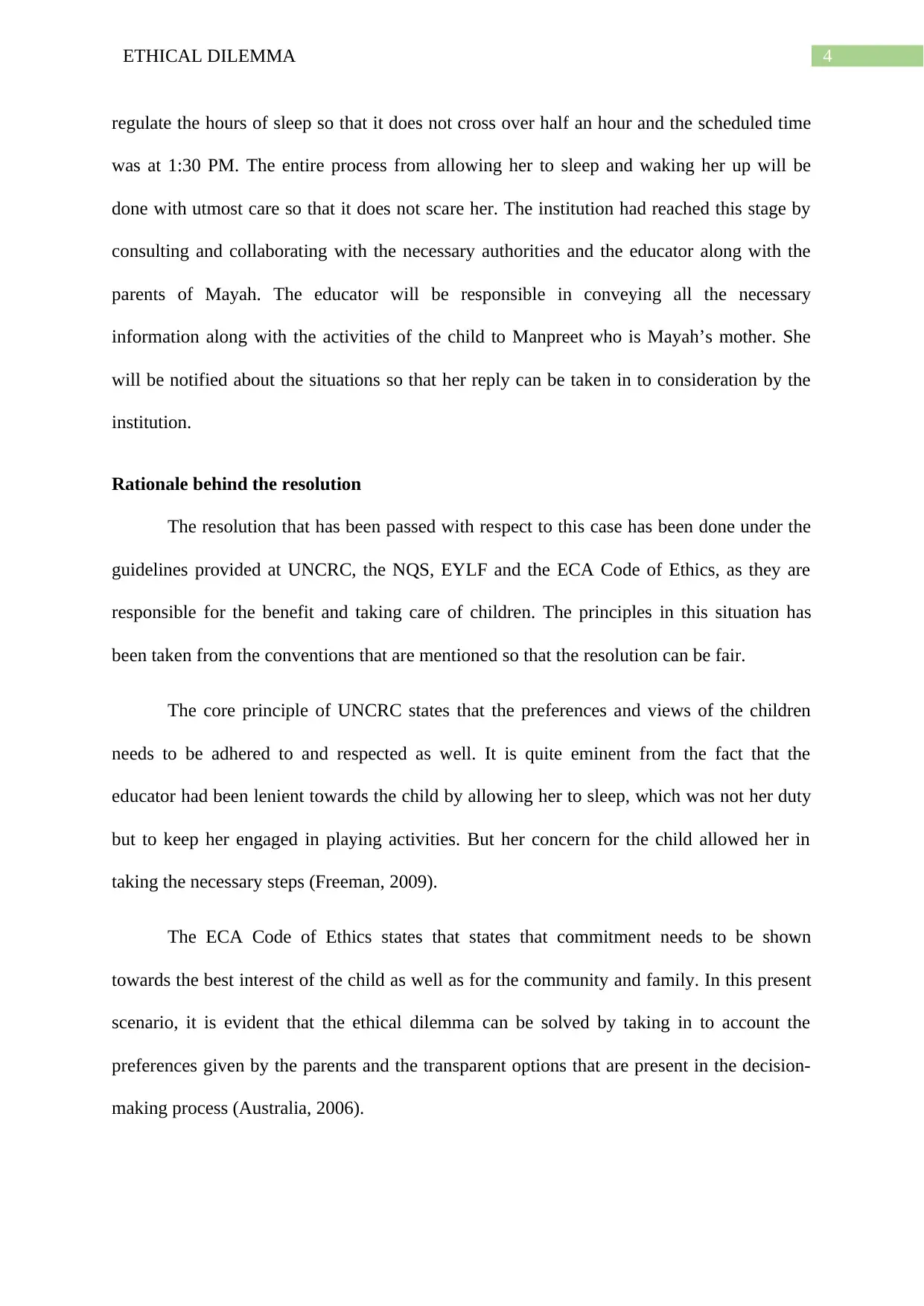
4ETHICAL DILEMMA
regulate the hours of sleep so that it does not cross over half an hour and the scheduled time
was at 1:30 PM. The entire process from allowing her to sleep and waking her up will be
done with utmost care so that it does not scare her. The institution had reached this stage by
consulting and collaborating with the necessary authorities and the educator along with the
parents of Mayah. The educator will be responsible in conveying all the necessary
information along with the activities of the child to Manpreet who is Mayah’s mother. She
will be notified about the situations so that her reply can be taken in to consideration by the
institution.
Rationale behind the resolution
The resolution that has been passed with respect to this case has been done under the
guidelines provided at UNCRC, the NQS, EYLF and the ECA Code of Ethics, as they are
responsible for the benefit and taking care of children. The principles in this situation has
been taken from the conventions that are mentioned so that the resolution can be fair.
The core principle of UNCRC states that the preferences and views of the children
needs to be adhered to and respected as well. It is quite eminent from the fact that the
educator had been lenient towards the child by allowing her to sleep, which was not her duty
but to keep her engaged in playing activities. But her concern for the child allowed her in
taking the necessary steps (Freeman, 2009).
The ECA Code of Ethics states that states that commitment needs to be shown
towards the best interest of the child as well as for the community and family. In this present
scenario, it is evident that the ethical dilemma can be solved by taking in to account the
preferences given by the parents and the transparent options that are present in the decision-
making process (Australia, 2006).
regulate the hours of sleep so that it does not cross over half an hour and the scheduled time
was at 1:30 PM. The entire process from allowing her to sleep and waking her up will be
done with utmost care so that it does not scare her. The institution had reached this stage by
consulting and collaborating with the necessary authorities and the educator along with the
parents of Mayah. The educator will be responsible in conveying all the necessary
information along with the activities of the child to Manpreet who is Mayah’s mother. She
will be notified about the situations so that her reply can be taken in to consideration by the
institution.
Rationale behind the resolution
The resolution that has been passed with respect to this case has been done under the
guidelines provided at UNCRC, the NQS, EYLF and the ECA Code of Ethics, as they are
responsible for the benefit and taking care of children. The principles in this situation has
been taken from the conventions that are mentioned so that the resolution can be fair.
The core principle of UNCRC states that the preferences and views of the children
needs to be adhered to and respected as well. It is quite eminent from the fact that the
educator had been lenient towards the child by allowing her to sleep, which was not her duty
but to keep her engaged in playing activities. But her concern for the child allowed her in
taking the necessary steps (Freeman, 2009).
The ECA Code of Ethics states that states that commitment needs to be shown
towards the best interest of the child as well as for the community and family. In this present
scenario, it is evident that the ethical dilemma can be solved by taking in to account the
preferences given by the parents and the transparent options that are present in the decision-
making process (Australia, 2006).
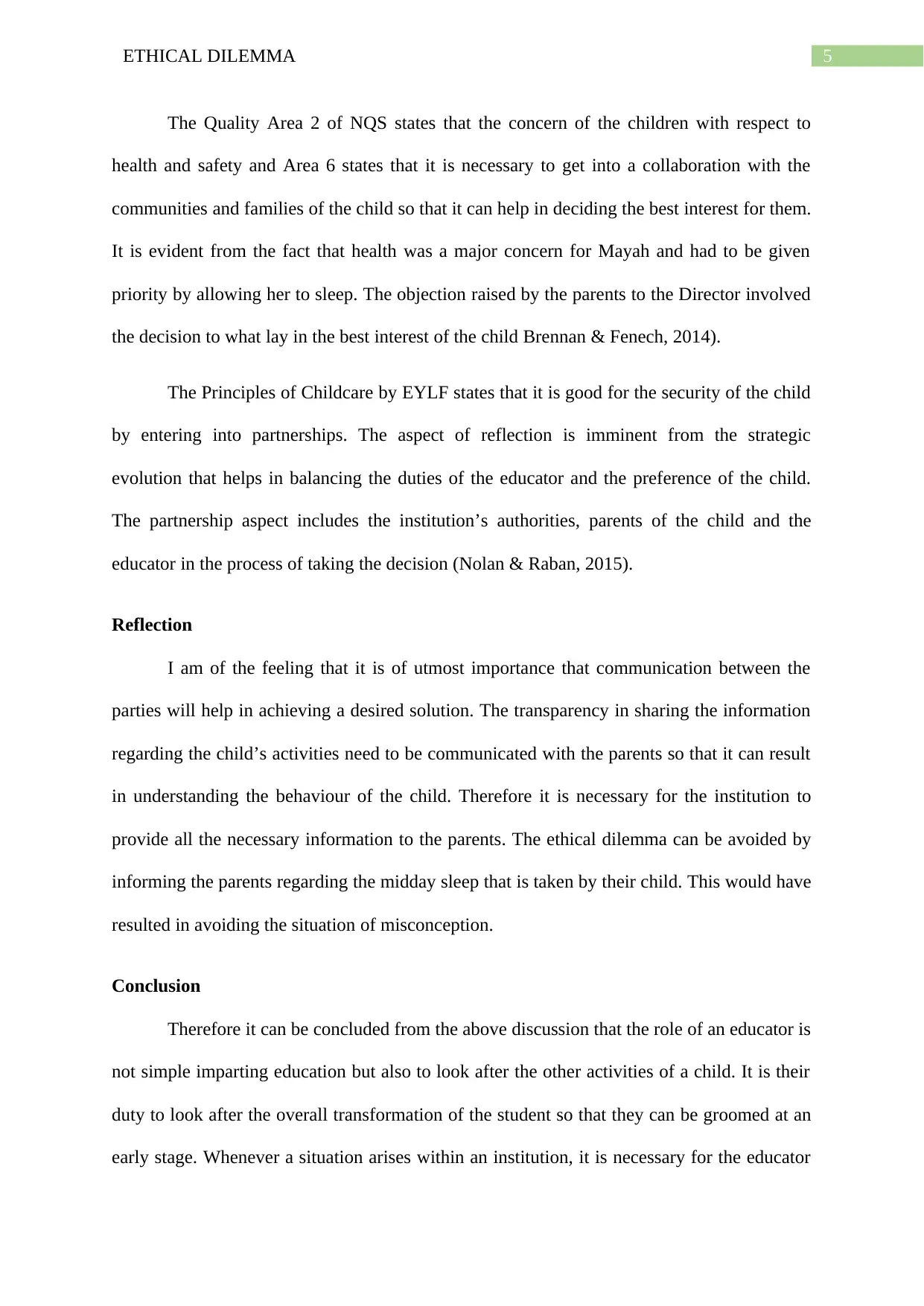
5ETHICAL DILEMMA
The Quality Area 2 of NQS states that the concern of the children with respect to
health and safety and Area 6 states that it is necessary to get into a collaboration with the
communities and families of the child so that it can help in deciding the best interest for them.
It is evident from the fact that health was a major concern for Mayah and had to be given
priority by allowing her to sleep. The objection raised by the parents to the Director involved
the decision to what lay in the best interest of the child Brennan & Fenech, 2014).
The Principles of Childcare by EYLF states that it is good for the security of the child
by entering into partnerships. The aspect of reflection is imminent from the strategic
evolution that helps in balancing the duties of the educator and the preference of the child.
The partnership aspect includes the institution’s authorities, parents of the child and the
educator in the process of taking the decision (Nolan & Raban, 2015).
Reflection
I am of the feeling that it is of utmost importance that communication between the
parties will help in achieving a desired solution. The transparency in sharing the information
regarding the child’s activities need to be communicated with the parents so that it can result
in understanding the behaviour of the child. Therefore it is necessary for the institution to
provide all the necessary information to the parents. The ethical dilemma can be avoided by
informing the parents regarding the midday sleep that is taken by their child. This would have
resulted in avoiding the situation of misconception.
Conclusion
Therefore it can be concluded from the above discussion that the role of an educator is
not simple imparting education but also to look after the other activities of a child. It is their
duty to look after the overall transformation of the student so that they can be groomed at an
early stage. Whenever a situation arises within an institution, it is necessary for the educator
The Quality Area 2 of NQS states that the concern of the children with respect to
health and safety and Area 6 states that it is necessary to get into a collaboration with the
communities and families of the child so that it can help in deciding the best interest for them.
It is evident from the fact that health was a major concern for Mayah and had to be given
priority by allowing her to sleep. The objection raised by the parents to the Director involved
the decision to what lay in the best interest of the child Brennan & Fenech, 2014).
The Principles of Childcare by EYLF states that it is good for the security of the child
by entering into partnerships. The aspect of reflection is imminent from the strategic
evolution that helps in balancing the duties of the educator and the preference of the child.
The partnership aspect includes the institution’s authorities, parents of the child and the
educator in the process of taking the decision (Nolan & Raban, 2015).
Reflection
I am of the feeling that it is of utmost importance that communication between the
parties will help in achieving a desired solution. The transparency in sharing the information
regarding the child’s activities need to be communicated with the parents so that it can result
in understanding the behaviour of the child. Therefore it is necessary for the institution to
provide all the necessary information to the parents. The ethical dilemma can be avoided by
informing the parents regarding the midday sleep that is taken by their child. This would have
resulted in avoiding the situation of misconception.
Conclusion
Therefore it can be concluded from the above discussion that the role of an educator is
not simple imparting education but also to look after the other activities of a child. It is their
duty to look after the overall transformation of the student so that they can be groomed at an
early stage. Whenever a situation arises within an institution, it is necessary for the educator
⊘ This is a preview!⊘
Do you want full access?
Subscribe today to unlock all pages.

Trusted by 1+ million students worldwide
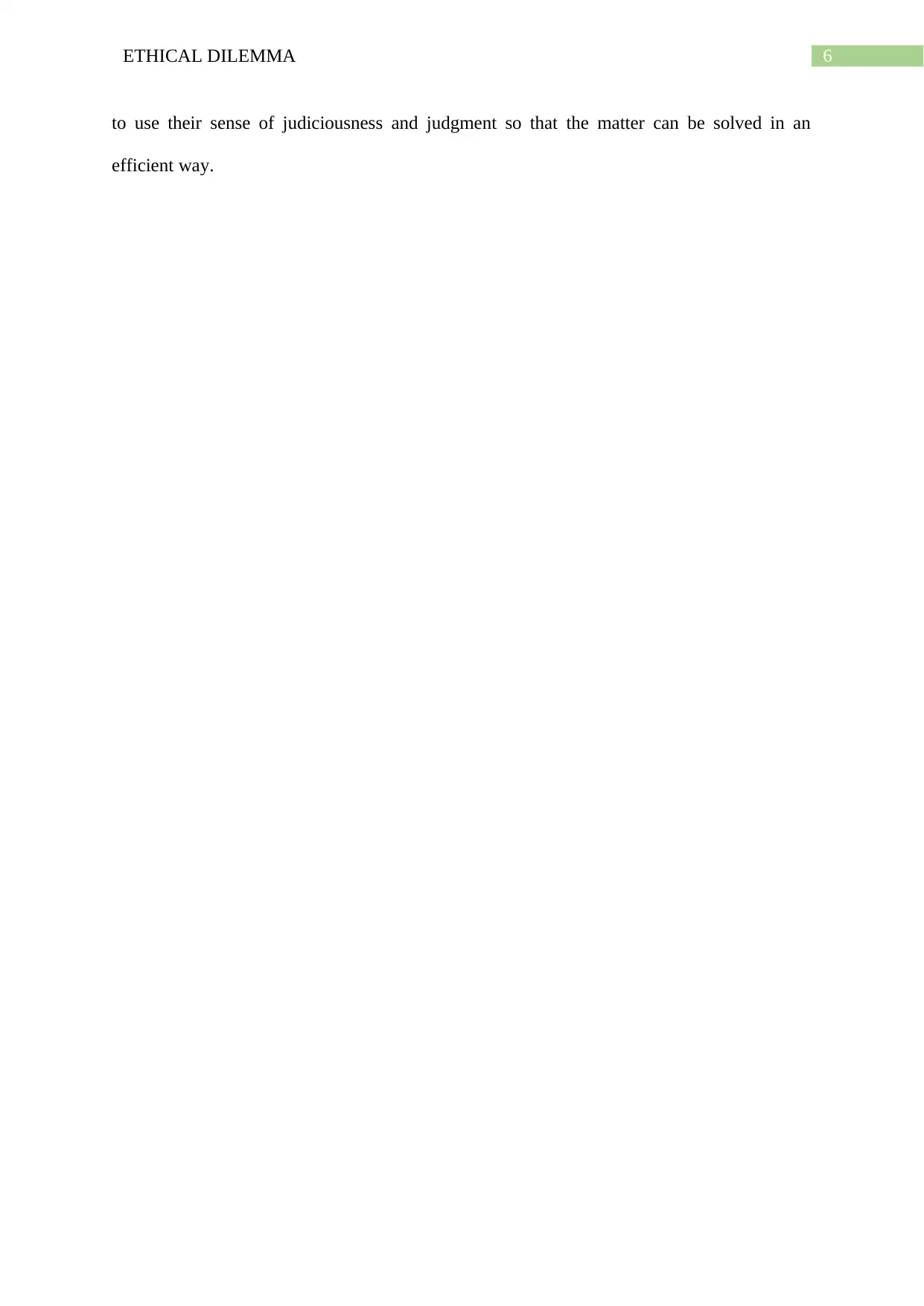
6ETHICAL DILEMMA
to use their sense of judiciousness and judgment so that the matter can be solved in an
efficient way.
to use their sense of judiciousness and judgment so that the matter can be solved in an
efficient way.
Paraphrase This Document
Need a fresh take? Get an instant paraphrase of this document with our AI Paraphraser
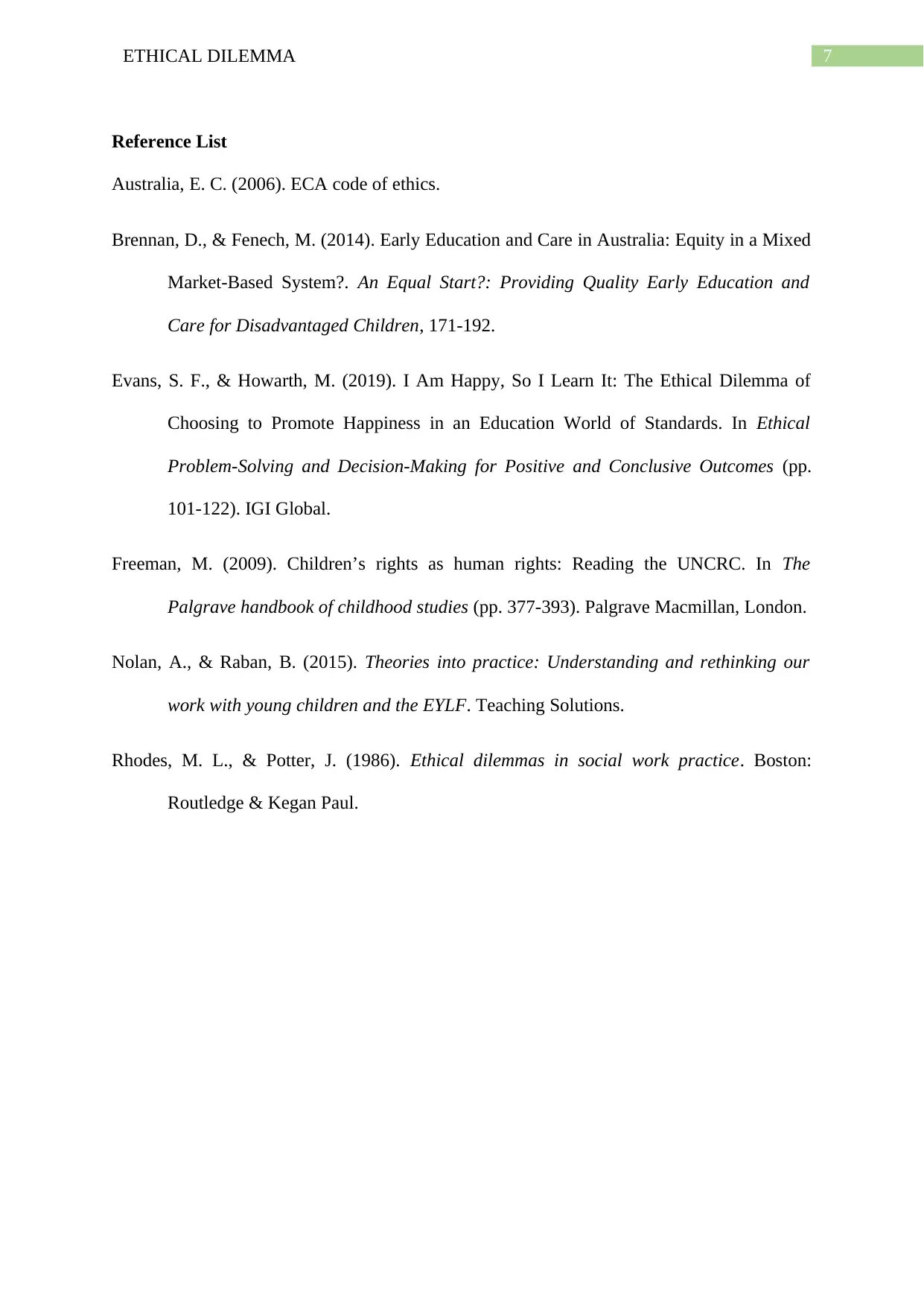
7ETHICAL DILEMMA
Reference List
Australia, E. C. (2006). ECA code of ethics.
Brennan, D., & Fenech, M. (2014). Early Education and Care in Australia: Equity in a Mixed
Market-Based System?. An Equal Start?: Providing Quality Early Education and
Care for Disadvantaged Children, 171-192.
Evans, S. F., & Howarth, M. (2019). I Am Happy, So I Learn It: The Ethical Dilemma of
Choosing to Promote Happiness in an Education World of Standards. In Ethical
Problem-Solving and Decision-Making for Positive and Conclusive Outcomes (pp.
101-122). IGI Global.
Freeman, M. (2009). Children’s rights as human rights: Reading the UNCRC. In The
Palgrave handbook of childhood studies (pp. 377-393). Palgrave Macmillan, London.
Nolan, A., & Raban, B. (2015). Theories into practice: Understanding and rethinking our
work with young children and the EYLF. Teaching Solutions.
Rhodes, M. L., & Potter, J. (1986). Ethical dilemmas in social work practice. Boston:
Routledge & Kegan Paul.
Reference List
Australia, E. C. (2006). ECA code of ethics.
Brennan, D., & Fenech, M. (2014). Early Education and Care in Australia: Equity in a Mixed
Market-Based System?. An Equal Start?: Providing Quality Early Education and
Care for Disadvantaged Children, 171-192.
Evans, S. F., & Howarth, M. (2019). I Am Happy, So I Learn It: The Ethical Dilemma of
Choosing to Promote Happiness in an Education World of Standards. In Ethical
Problem-Solving and Decision-Making for Positive and Conclusive Outcomes (pp.
101-122). IGI Global.
Freeman, M. (2009). Children’s rights as human rights: Reading the UNCRC. In The
Palgrave handbook of childhood studies (pp. 377-393). Palgrave Macmillan, London.
Nolan, A., & Raban, B. (2015). Theories into practice: Understanding and rethinking our
work with young children and the EYLF. Teaching Solutions.
Rhodes, M. L., & Potter, J. (1986). Ethical dilemmas in social work practice. Boston:
Routledge & Kegan Paul.
1 out of 8
Related Documents
Your All-in-One AI-Powered Toolkit for Academic Success.
+13062052269
info@desklib.com
Available 24*7 on WhatsApp / Email
![[object Object]](/_next/static/media/star-bottom.7253800d.svg)
Unlock your academic potential
Copyright © 2020–2025 A2Z Services. All Rights Reserved. Developed and managed by ZUCOL.





